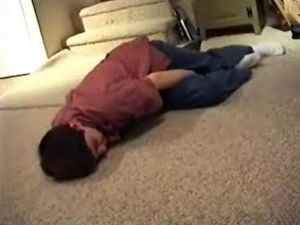Narcolepsy facts for kids

Narcolepsy is a sleep disorder that affects the brain. It makes it hard for people to control when they fall asleep. People with narcolepsy often feel very sleepy during the day, even if they slept enough at night. They might fall asleep suddenly, even when they don't want to.
This condition happens because the nervous system (which controls how your body works) doesn't manage sleep and wakefulness properly. Narcolepsy is not a mental illness or caused by emotional problems. It's a physical problem with the brain. About 25 to 50 out of every 100,000 people have narcolepsy.
The first time narcolepsy was described was in 1877. A doctor named Jean-Baptiste Gélineau first used the name "narcolepsy" in 1880. In some places, people with narcolepsy might not be allowed to drive cars because of the sudden sleepiness.
Contents
What Are the Signs of Narcolepsy?
The main signs of narcolepsy are feeling very sleepy during the day and having unusual REM sleep. Even after a good night's sleep, someone with narcolepsy might feel tired or fall asleep easily. This can happen at school, during a conversation, or in other unexpected places.
People with narcolepsy don't get the deep, refreshing sleep that most people do. This means they often feel like they haven't slept enough, even if they spent many hours in bed. They might feel tired all the time, as if they are always sleep-deprived.
Daytime Sleepiness
Feeling sleepy during the day can be different for everyone. It often happens when someone is doing something boring or not very active. Daytime naps can come on very quickly and be hard to stop. These naps usually make the person feel better for a short time, maybe a few hours. People with narcolepsy might also have very vivid dreams, even during short naps.
Unusual REM Sleep
REM sleep is the stage of sleep where you dream. For most people, REM sleep happens later in the night. But for people with narcolepsy, REM sleep can start very soon after they fall asleep, even during daytime naps.
Other Common Symptoms
The classic signs of narcolepsy include:
- Cataplexy: This is a sudden loss of muscle control.
- Sleep paralysis: This is when you can't move or talk when waking up or falling asleep.
- Hypnagogic hallucinations: These are vivid, dream-like experiences when falling asleep.
- Excessive daytime sleepiness: As mentioned above, feeling very tired during the day.
Not everyone with narcolepsy will have all these symptoms.
What is Cataplexy?
Cataplexy is a sudden weakness in the muscles. It can be mild, like a slight weakness in the neck or knees, or it can cause a full body collapse. These episodes are often triggered by strong emotions like laughter, anger, surprise, or fear. During cataplexy, the person stays awake and aware of what's happening. Their speech might be slurred, and their vision might be blurry, but they can still hear and know what's going on.
Cataplexy can be very upsetting and make people worried about being in situations that might trigger an attack. It's like the body's natural sleep paralysis (which stops you from acting out dreams) happens when you're awake.
Sleep Paralysis and Hallucinations
- Sleep paralysis is when you temporarily can't talk or move when you're waking up or, less often, when you're falling asleep. It usually lasts only a few seconds to a few minutes. It can be scary, but it's not dangerous.
- Hypnagogic hallucinations are vivid, dream-like experiences that happen as you're falling asleep. They can be frightening. If they happen when you're waking up, they are called hypnopompic hallucinations. These can involve seeing or hearing things that aren't really there.
Usually, the first symptom to appear is feeling very sleepy during the day. The other symptoms might start months or even years later. Only about 20 to 25 percent of people with narcolepsy have all four main symptoms. The daytime sleepiness usually lasts a person's whole life, but sleep paralysis and hallucinations might not.
People with narcolepsy can also gain weight. Children might gain about 20 to 40 pounds when they first develop the condition.
What Causes Narcolepsy?
Scientists don't know the exact cause of narcolepsy. It might be caused by several different things. One main reason is the loss of special brain cells that make a chemical called orexin (also known as hypocretin). Orexin helps control whether you are awake or in REM sleep.
People with narcolepsy who also have cataplexy (called type 1 narcolepsy) usually have very low levels of orexin. This chemical acts like a messenger between nerve cells in the brain.
In some cases (up to 10%), narcolepsy runs in families. This is more common when cataplexy is present. There's also a strong link to certain genes. These genes might make the immune system mistakenly attack the orexin-making brain cells. This can sometimes happen after an infection, like the H1N1 flu.
Besides genes, low orexin levels have been linked to past infections, diet, contact with certain chemicals, and brain injuries from head trauma, brain tumors, or strokes.
Treatments for Narcolepsy
There are medicines that can help manage the symptoms of narcolepsy. These medicines can't cure the cause, but they can make life easier. They are usually special kinds of stimulants. Regular stimulants like coffee usually don't help much.
There are also ways to manage narcolepsy without medicines:
- Changing daily habits: This means learning to avoid situations that might trigger sudden sleepiness. It also involves adjusting your daily schedule to include planned naps. This is often called coping.
- Sleep hygiene: This means having good habits around sleep, like going to bed and waking up at the same time each day, and making sure your bedroom is dark and quiet.
See also
 In Spanish: Narcolepsia para niños
In Spanish: Narcolepsia para niños

